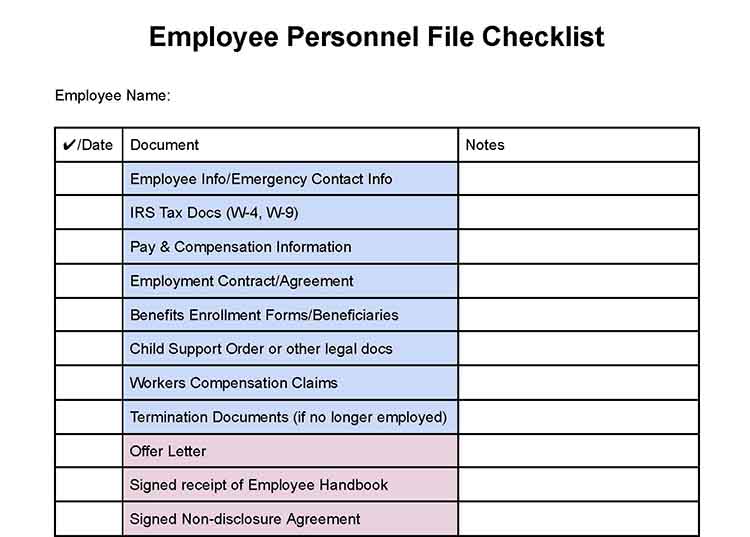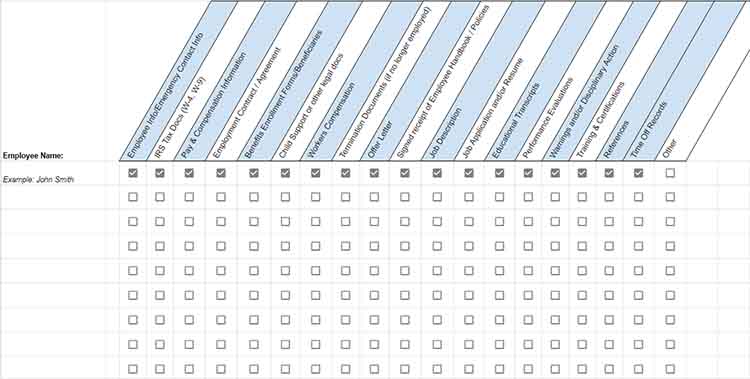
Explore what documents to keep in an employee personnel file—and which to keep out. Watch our instructional video and download checklists to stay compliant.
Published June 19, 2023
Published Jun 19, 2023
This article is part of a larger series on How to Do Payroll.
Table of ContentsA personnel file is a paper or electronic folder kept for each employee—new, existing, and past—that contains HR and payroll documents. The documents within an employee personnel file should cover the entire employment lifecycle, from offer letters and W-4 forms to performance reviews and termination paperwork. It should also include basic employee documents and compensation information in compliance with federal and state labor laws.
Download our free checklists to help you keep track of what employee personnel file records to store; these can be edited to add documents specific to your company. Then, continue reading for more specific information on what to include and not include in a secure personnel file.
FILE TO DOWNLOAD OR INTEGRATE
Employee Personnel File Checklist
Download as Word Doc Download as Google Doc Download as PDF
Need help keeping track of your personnel files?
Let Rippling do all the work for you. They can collect and store all personnel file paperwork in one safe place.

Need help keeping track of your personnel files?
Let Rippling do all the work for you. They can collect and store all personnel file paperwork in one safe place.
As repositories of important information related to individual employees, employee personnel files should include legal documents, company documents, and employee documents.
There are several employee-related HR and payroll documents that every personnel file must contain. These include legal employment records—such as payroll tax forms and employee-employer agreements.
The legal documents that every employee personnel file must have are:
For a full list of payroll forms you may need or if you have more general questions about payroll, take a look at our guide on employer payroll forms or our How to Do Payroll article.
Company and policy documents should be included in an employee’s personnel file so they can be easily accessed by the employee’s manager, payroll team, or employee if needed. While not required, these company documents (such as signed policies) are good to keep on file.
These should show when the employee acknowledged or signed certain policy documents in case of legal issues:
*In some states, employers are required to maintain sick time off records. If they’re not stored electronically within your payroll system, it’s a good idea to keep them in the employee’s personnel folder.
While you don’t have to keep every document in an employee personnel file, it is a good practice to keep documents collected upon hiring, such as a resume or job application. Additionally, any written performance documents (such as goal-setting records or disciplinary actions) can be kept in a personnel file.
NOTE: Items such as background checks and drug test results are confidential documents and should be kept in a separate file from all employee personnel-related documents.
Companies can use an employee management platform like Rippling to safeguard personnel files and other employee documents. With it, all people operations are done in one place—from onboarding to offboarding, including document management. You can manage and automate employee data and operations easily to ensure compliance. Plus, when you sign up for Rippling, your first month will be free.
There are also documents that you should not include in the employee’s personnel folder, primarily because of confidentiality. These include the following:
Business owners don’t always realize the importance of setting up personnel files until they’re audited or served with a lawsuit. If you are operating in hindsight and nervous about getting everything set up for employees that already exist, don’t stress. Use the two checklists we’ve provided above, along with the steps for you to get your employee file folders set up and in order.
You should complete the following for organizing and storing personnel records to ensure compliance and security:
Step 1: Take InventoryFirst, you need to take an inventory of what you already have for each employee. Ideally, create a personnel file for each employee on the date of hire. However, if you forget to do so, you can find documents—like employee resumes, performance reviews, and tax forms—in your email or online storage. Make sure you also have I-9s for each employee as well, but they should be kept in a separate file.
Use an employee personnel file checklist to make sure everything is in order. Each person might require their own list.
FILE TO DOWNLOAD OR INTEGRATE
Employee Personnel File Checklist
Download as Word Doc Download as Google Doc Download as PDF
Need help keeping track of your personnel files?
Let Rippling do all the work for you. They can collect and store all personnel file paperwork in one safe place.
If there are documents on your list that you cannot find in your files, you can request these documents from your employees. Give each employee their checklist to show what they need to submit to update their personnel file. Set a due date for all employee documents to be in and complete. Be sure to review each employee’s list with them present so that if anything was not submitted, you can address it right away. Follow up with each employee you requested additional documents from before the deadline so that everyone has time to submit the missing documents. Then, store your documents online, on your computer network, or in a locked file cabinet.
Step 2: Store DocumentsYou will want to store your personnel documents in a file folder marked specifically for each employee by name. We recommend that you keep employee personnel files in a locked cabinet to safeguard confidential employee information from unauthorized personnel. Access to employee files should be limited to an authorized individual or department whose permission is needed to view the files, such as HR. Documents can also be stored online with an encrypted service. Rippling provides secure online document storage, including copies of employee contracts, policies, and a copy of your employee handbook.
With Rippling, you can store employee personnel files directly in the system under each employee. Step 3: Establish a Regular Personnel File AuditSchedule a periodic review of each employee’s personnel file as part of your HR compliance. This can be done when you conduct their annual evaluation. Ensure that the files are accurate, up-to-date, and complete. If not, you can ask the employee to provide you with the updated files or information. Your business should verify that files are in order before any audits, such as payroll or labor. Use a personnel file audit checklist to help keep track.